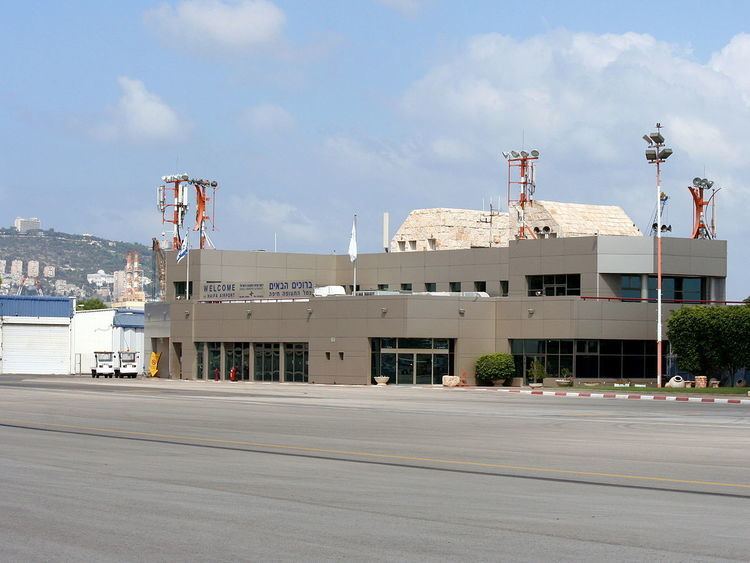Airport type Military/Public Elevation AMSL 28 ft / 9 m 4,324 1,318 Code HFA Phone +972 4-847-6111 | 16/34 4,324 Elevation 9 m | |
 | ||
Similar Haifa Airport, Arad/Suva, Israel Railway Museum, Haifa Center HaShmona, Kiriyat Motzkin | ||
Landing at haifa airport israel
Haifa International Airport (Hebrew: נְמַל הַתְּעוּפָה חֵיפָה, Namal HaTe'ufa Haifa; Arabic: مطار حيفا) (IATA: HFA, ICAO: LLHA), also known as U Michaeli Airport is a small international airport located in Haifa, Israel. It is located to the east of the city, close to Kishon Port and Israel Shipyards and mainly serves civilian flights, with some military usage. Most passenger flights utilizing the airport are domestic operations to Eilat and Tel Aviv. The airport is named after Uri Michaeli, one of the pioneers of Jewish aviation and one of the founders of aviation in Israel. The airport has one short runway, 1,318 metres (4,324 ft) in length, and there are plans to extend it onto reclaimed land in the Gulf of Haifa.
Contents
- Landing at haifa airport israel
- Tus airways saab 340b first flight to haifa airport lca hfa amazing scenery gopro wing view
- History
- RAF Haifa
- Haifa Airport 1948 On
- Plans
- References
Tus airways saab 340b first flight to haifa airport lca hfa amazing scenery gopro wing view
History
Haifa Airport was established by the British Mandate in 1934, as its first international airport, originally serving the British Army and the Iraqi-British oil company, APS. In 1936 passenger services to Beirut and Cyprus were opened, and in 1938 a regular route to Italy commenced. In 1938 a third of flights into Mandatory Palestine landed in Haifa but in 1940, civil flights were stopped due to the Second World War in which the airport served the Royal Air Force's operations in the Middle East as RAF Haifa.
RAF Haifa
RAF Haifa was a Royal Air Force station in Mandatory Palestine between 1942 and 1948.
Haifa Airport had been established in 1934, as the first international airport in Mandatory Palestine, originally serving the British Army and the Iraqi-British oil company, APS. In 1940 civil flights were stopped due to the Second World War and it became RAF Haifa. The RAF station closed in 1948 and the airport re-opened as Haifa Airport.
Operational units at RAF Haifa 1942 to 1948:
Haifa Airport 1948 On
The airport reopened for passenger traffic in 1948 with flights operated by Cyprus Airways. This was followed ten years later by Arkia Israel Airlines flights. It wasn't until 1994, however, that the airport received international status, and at this time, it was planned that the airport would serve flights to destinations across Europe. Less than a year later, the airport was placed for sale. At this time, great interest in the site was shown by the French construction group, Bouygues as well as British Aerospace.
These expected services never really took off however, and it wasn't until 1996, and the start of Israir flights, that the airport grew. This growth was further increased in 1998 with Aeroel service. Royal Wings increased route offerings once again with flights from Jordan, whilst Scorpio started flights to Egypt. In 1998, a new terminal was opened at the airport to cater for all of the services needed in a modern international airport. In the past there were three takeoff and landing runways in the airport, of which only two still exist, and only one is currently in use.
In 2001, talk over expanding the airport restarted when then Finance Minister, Silvan Shalom called for an 800 million NIS upgrade to turn the airport into one of an international standard.
2007 saw the first rise in passenger numbers and aircraft movements since 2002 with an increase of 25% in passenger numbers and a 7% increase in aircraft movements over the previous year. In general, between the peak point of its operation in 1999 and 2007 passenger number have fallen by 50%. Aircraft movements have decreased from 2002 to 2007 by 34%.
Plans
The Israel Airports Authority intends to extend the runway to 1,634m by the middle of the 2010s decade. As part of the later phases of the Haifa Seaport expansion plan, plans are being considered to greatly extend the length of the airport's runway (onto reclaimed land in Haifa Bay), allowing for long-haul narrow-body aircraft operations.
